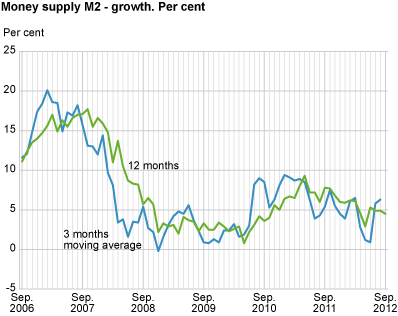Content
Published:
This is an archived release.
Decreased money supply growth
The twelve-month growth in total money supply (M2) was 4.5 per cent to end-September, down from 4.9 per cent to end-August. The decrease stems from non-financial enterprises and other financial enterprises.
The total money supply amounted to NOK 1 759 billion at end-September, up from NOK 1 745 billion at end-August.
Increase in money supply growth for households
Households’ money supply constitutes more than half of the total money supply. At end-September it accounted for NOK 966 billion, down from NOK 967 billion the previous month. The twelve-month growth in households’ money supply increased from 8.2 per cent to end-August to 8.5 per cent to end-September.
The growth in households’ money supply was higher than the growth in households’ gross domestic debt, which amounted to 7 per cent to end-September, according to the credit indicator C2 . For more information on the financial position of households, see the financial accounts in the national accounts .
Decrease in the money supply growth for non-financial enterprises
Non-financial enterprises’ money supply amounted to NOK 540 billion at end-September, up from NOK 535 billion at end-August. The twelve-month growth decreased from 0.1 per cent to end-August to -0.3 per cent to end-September. Non-financial enterprises’ money supply constituted 30.7 per cent of the total money supply and 39.5 per cent of their gross domestic debt measured by the credit indicator C2 at end-August.
Increase in money supply growth for municipal government
Municipal government’s money supply amounted to NOK 78 billion at end-September, up from NOK 68 billion the previous month. The twelve-month growth rate was 8.5 per cent to end-September, up from 7.9 per cent to end-August.
Decrease in growth for other financial enterprises
Other financial enterprises’ money supply amounted to NOK 175 billion at end-September, marginally up from NOK 174 billion at end-August. The twelve-month growth was -3.2 per cent to end-September, down from 1.3 per cent the previous month.
| March 2012 | April 2012 | May 2012 | June 2012 | July 2012 | August 2012 | September 2012 | |||||||||||||||||||||||||||||||||||||||||||||||||||||||||||||||||||||||||
|---|---|---|---|---|---|---|---|---|---|---|---|---|---|---|---|---|---|---|---|---|---|---|---|---|---|---|---|---|---|---|---|---|---|---|---|---|---|---|---|---|---|---|---|---|---|---|---|---|---|---|---|---|---|---|---|---|---|---|---|---|---|---|---|---|---|---|---|---|---|---|---|---|---|---|---|---|---|---|---|
| M0 - 12 mth. | -13.8 | -0.4 | -19.7 | 1.9 | -19.2 | -18.2 | -10.5 | ||||||||||||||||||||||||||||||||||||||||||||||||||||||||||||||||||||||||
| M1 - 12 mth. | 5.9 | 3.7 | 1.0 | 5.0 | 2.6 | 3.8 | 3.8 | ||||||||||||||||||||||||||||||||||||||||||||||||||||||||||||||||||||||||
| M2 - 12 mth. | 6.1 | 4.6 | 2.9 | 5.3 | 4.9 | 4.9 | 4.5 | ||||||||||||||||||||||||||||||||||||||||||||||||||||||||||||||||||||||||
| M2 - 3 mth. moving average1 | 6.5 | 2.8 | 1.2 | 0.9 | 5.8 | 6.3 | |||||||||||||||||||||||||||||||||||||||||||||||||||||||||||||||||||||||||
| M2 households - 12 mth. | 8.2 | 7.8 | 8.2 | 8.4 | 7.6 | 8.2 | 8.5 | ||||||||||||||||||||||||||||||||||||||||||||||||||||||||||||||||||||||||
| M2 non-financial enterprises - 12 mth. | 3.0 | 0.4 | -3.7 | 1.5 | 2.5 | 0.1 | -0.3 | ||||||||||||||||||||||||||||||||||||||||||||||||||||||||||||||||||||||||
| 1 | Annualised figure. |
Composition of money supply
The broad monetary aggregate M2 amounted to NOK 1 759 billion at end-September, of which the major part, 91.9 per cent, consisted of bank deposits. In comparison, notes and coins only accounted for 2.6 per cent. The rest of the broad monetary aggregate consisted of shares in money market funds and certificates of deposits, which accounted for 5.4 and 0.2 per cent respectively.
Change in base money
Base money (M0) amounted to NOK 99 billion at end-September, up from NOK 81 billion the previous month. The twelve-month growth in M0 increased from -18.2 per cent to end-August to -10.5 per cent to end-September.
The statistics is published with Monetary aggregates.
Contact
-
Statistics Norway's Information Centre
E-mail: informasjon@ssb.no
tel.: (+47) 21 09 46 42

